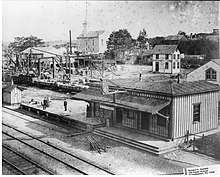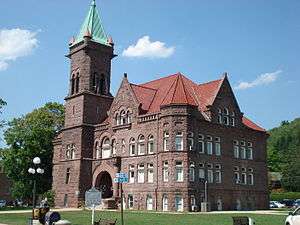Hummelstown Brownstone Company
From 1863 to 1929, the Hummelstown Brownstone Company (HBC) owned and operated quarries in the Hummelstown, Pennsylvania area which produced Hummelstown brownstone, once widely used as a building stone throughout the US. The quarries of the HBC are listed on the National Register of Historic Places.[2]

Quarries of the Hummelstown Brownstone Company | |
 | |
  | |
| Location | Roughly N of Brookline Dr., Amber Dr., Derry Township, Pennsylvania |
|---|---|
| Coordinates | 40°13′48″N 76°41′30″W |
| Area | 21 acres (8.5 ha) |
| Built | 1863 |
| NRHP reference No. | 03000075[1] |
| Added to NRHP | February 27, 2003 |
History and operations
Hummelstown brownstone pits were first opened by early German settlers in the late 18th Century. The HBC itself (originally known as the Pennsylvania Brown Free Stone Company) was founded by Allen Walton and the quarries employed many immigrant skilled stone-cutters and laborers.

At the height of its production, the HBC employed about 500 men in quarrying and finishing the stone. Most of the skilled workers were Italian, German, and Scotch-Irish immigrants. However, because the nature of the stone made it impossible for the stone to be quarried in the cold of winter, only the skilled workers were kept on during the winter months.[2]
Although not as large as the vast brownstone quarries at Portland, Connecticut, the Hummelstown operation was their equal in every respect and a viable competitor of most other brownstone quarries including those at Medina and Moscow, New York.[2]
The Walton family published an advertising booklet around 1910 which listed almost 400 structures built of their stone.
References
- "National Register Information System". National Register of Historic Places. National Park Service. July 9, 2010.
- "National Historic Landmarks & National Register of Historic Places in Pennsylvania" (Searchable database). CRGIS: Cultural Resources Geographic Information System. Note: This includes Ben F. Olena and Bill Blubaugh (July 2001). "National Register of Historic Places Inventory Nomination Form: Quarries of the Hummelstown Brownstone Company" (PDF). Retrieved 2011-11-12.
Further reading
- Olena, Ben F., "Hummelstown Brownstone - Five Quarries Mined the Prized Sandstone from 1867-1929", In: Pennsylvania [magazine] Vol. 19, No. 6, November/December 1996, pages 26–29 [with four historical photographs].
- Stone, Ralph W., Building Stones of Pennsylvania.
External links
![]()
- Hummelstown Brownstone Quarry History
- (PDF) Hummelstown Brownstone Company, Waltonville, Pennsylvania, early 1900s booklet on Stone Quarries and Beyond.
- Hummelstown Brownstone: A study of the Hummelstown brownstone industry and its contribution to the American building arts, by Ben F. Olena on Stone Quarries and Beyond.

